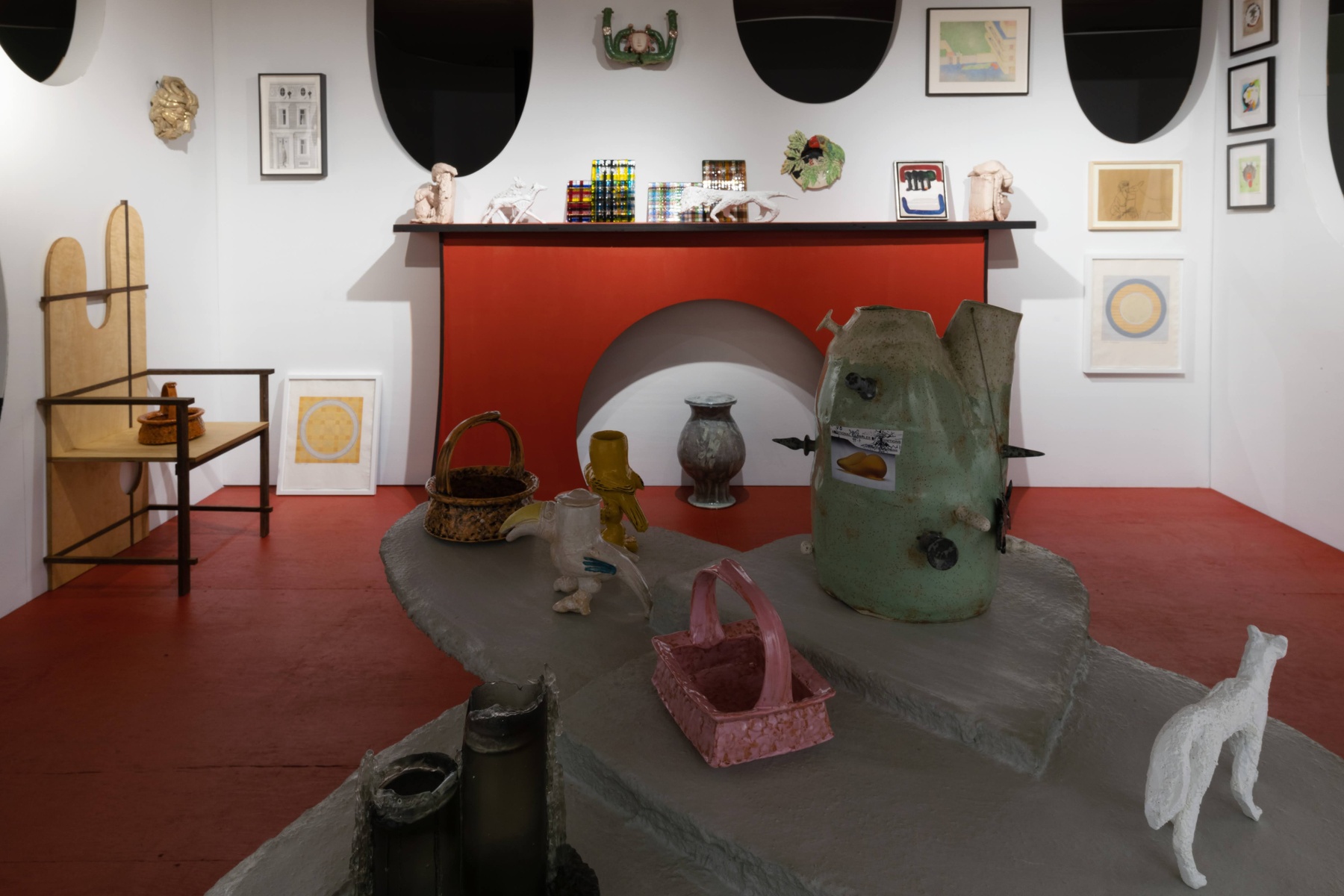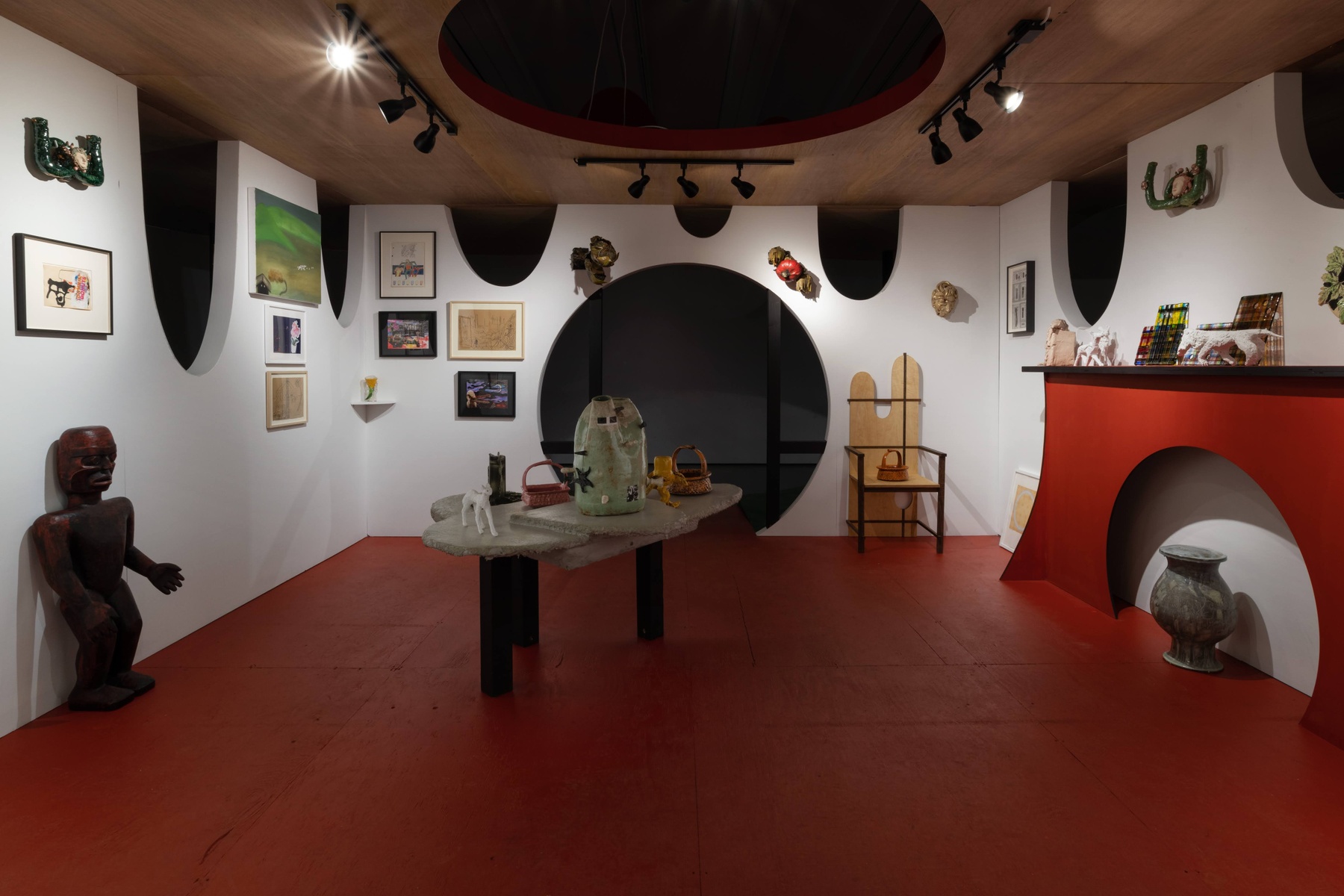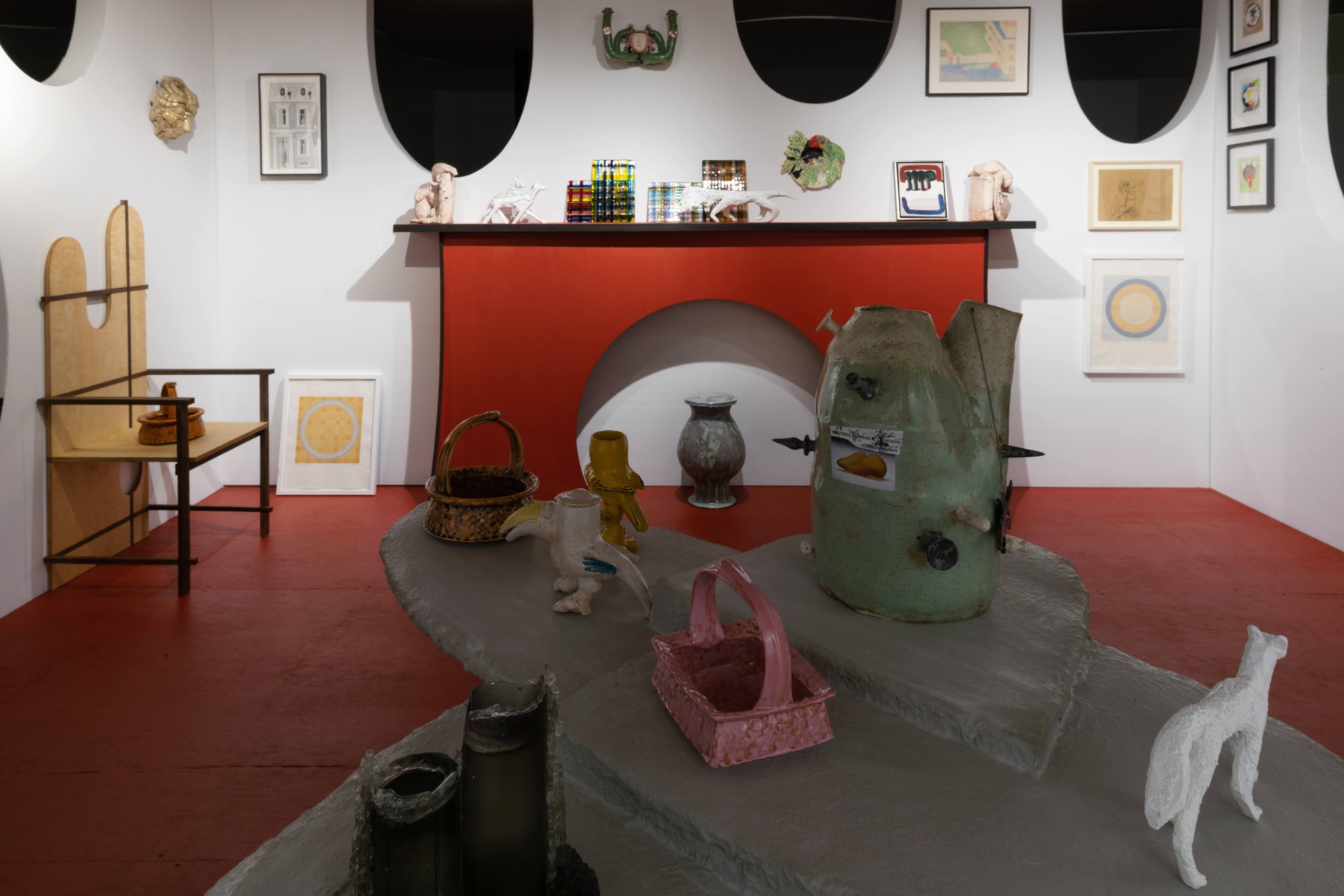Winterfest: An Exhibition of Arts and Crafts
Winterfest: An Exhibition of Arts and Crafts consists of handmade artworks by local, national, and international contemporary artists from across the United States, Canada, and Europe. Rather than the formal presentation of a group show, these artworks are displayed within an exhibition architecture representing a cabin, mountains, and a lake, designed by US-based German artist Veit Laurent Kurz.
Kurz is well known for creating a number of immersive installations that have interpreted traditional Alpine cabin structures to house artist-curated exhibitions. For Winterfest, he again takes the natural landscape as inspiration for experimental architecture, this time creating an ambitious, large-scale installation as a surreal, festive backdrop for works that fall between arts and crafts.
Winterfest is based on the German tradition of jahresgaben—annual selling exhibitions conducted by kunstvereine (member-based art associations throughout Germany). Since the 1800s, these exhibitions have been mounted in Germany to support artists, as well as help fund the institutions’ programs. As such, Winterfest will financially aid artistic practice, with profits split between artists and the museum.
The exhibition features works by Kelly Akashi, Kerstin Brätsch, Beverly Buchanan, Richard Carter, Milano Chow, Beau Dick, Olivia Erlanger, Gina Fischli, Viola Frey, Owen Fu, Rochelle Goldberg, Jonas Lipps, Soshiro Matsubara, Malcolm Mooney, Brandon Ndife, Erin Jane Nelson, Precious Okoyomon, Silke Otto-Knapp, Matthew Langan-Peck, Giangiacomo Rossetti, Lin May Saeed, Niki de Saint Phalle, Cole Speck, Stefan Tcherepnin, and Amelie von Wulffen.
For more information please visit Aspen Art Museum.
by Osman Can Yerebakan, BOMB*
Writing these words about artist Lin May Saeed, I hear my dog make noises in his sleep. I try to see beyond the veil that curtails my understating of him, but I still tend to see my dog through my human experience: “He must be having a bad dream.…” Saeed’s recently closed first museum survey, Arrival of the Animals, at the Clark Art Institute started with a physical veiling: a sheer curtain separated a selection of her drawings and etchings that depict animal and human relationships. On the other side of this divide was a small collection of works from the Clark also featuring animals. In Saeed’s art, animals are mostly silent and peaceful, particularly in her use of warm colors as well as her attribution of tranquility to the otherwise gory history between animals and humans.
In tandem with her being included in the Aspen Art Museum’s Winterfest: An Exhibition of Arts and Crafts and her upcoming participation in the Amsterdam Sculpture Biennale and Fondation Carmignac’s La Mer imaginaire exhibition, Saeed answered my questions from her Berlin studio, which she shares with her two rabbits.
Osman Can Yerebakan
Seeing your show at the Clark took me back to La Fontaine’s fables. Growing up, we would read them because each story had a lesson to take, a virtue to underline, always delivered by an animal. Are you in interested in traditional fables?
Lin May Saeed
Yes, fables have always fascinated me, or even stories in which animals as protagonists formulate criticisms of power. Fables articulate the possibility of an alternative human and animal relationship. I call my short texts, which are published in the catalogue for Arrival of the Animals, fables.
OCY
Animal activism is distinct from other movements due to its subject matter’s silence and inability to express itself. Unlike other movements in which humanity’s progress toward a certain direction is the core incentive, in animal activism the subject is unaware of and unable to join the fight. What do you think about this dynamic between animals and activists?
LMS
This has been on my mind for a long time, and I have ideas about it, but they don’t really get to the heart of the question or its potentiality. For one thing, I only partially agree with the question. Although animals cannot speak, they can convey how they are. An example from the dairy industry: a cow and a calf, separated from each other in the animal factory, call out to one another for days on end. These sounds do not require speech to be understood. They sound very sad and hoarse; eventually they fall silent. The consumer who buys a yogurt in the supermarket does not hear them because they are too far away, in every way. If the sounds of those cows and calves could be heard over loudspeakers in the supermarket, probably less yogurts would be sold.
It is true that animals are usually not able to participate in their liberation, but they behave differently when they are liberated and have better living conditions. Evidence of this changed, obviously happier behavior can be seen in numerous videos in social media. This footage has a role in strengthening the animal movement. To that extent, animals make a substantial contribution to the animal liberation movement.
When I see a utopian approach to your question, my favorite daydream comes to mind involving how climate change is solved. Animals and aliens give a master class for homo sapiens called: How Not To Mess It Up.
OCY
In this vein, from an institutional aspect, making art about a movement that cannot be championed by its subject matter requires a certain type of investment. Unlike other race, gender, religion, or class-based social groups whose well-being may be the subject of art, animals can never collect, curate, write about, or support works about them.
LMS
In art and art history, anthropocentrism, which is still the dominant ideology, continues to be reflected. When I’m in the studio, my two rabbits are not interested in the visual art I make. At most, they’re interested in the material, for example, to build a nest out of it. The rabbits tamper with the sculptures while they are in the process of being created, and that is usually even helpful. Conversely, I also build things especially for them.
I try to fill the communication gap as well as I possibly can and make the work somehow useful for other animals, especially when working for outdoors. We placed the bronze sculpture Thaelab/Fox (2017), which is flat on top, outside the Clark so that it could serve as a tray for nuts that can be picked by wild animals.
If you ask who the human addressees of my work are, since animals are only to a very limited extent, they are people who find it legitimate that I, as a contemporary artist, negotiate this material. Some of them do not eat meat. Among those who do not find the subject of animal liberation legitimate for art, there are, as far as I experienced, no vegetarians.
OCY
Styrofoam is plentiful, especially in urban areas, such as Berlin, but it’s also an extremely difficult material to work with. How did you learn to tame and make peace with this material over the years?
LMS
I learned to appreciate Styrofoam early. For my final thesis at the Düsseldorf Art Academy in 2001, I made a sculpture of the Capitoline Wolf, which belongs to the founding myth of the city of Rome. I produced it in a non-speciesist version that was as big as a room-sized cave installation. Working with Styrofoam and getting used to the material was one thing. It was an additional step not to hide the material behind a layer of plaster or synthetic resin, which was an intuitive decision back then. From today’s perspective, I even consider it crucial that the material is not hidden. I only prime the sculpture after the working process. This gives it a slightly more compact surface and stabilizes the material, but it is still open, like cellular concrete. I also like the way it makes visible the apparently smallest units, its mini-spheres, and to imagine that they are atoms.
I studied in Düsseldorf in the ’90s and experienced the atmosphere there as liberating and beneficial for me. But I perceived that sculpture was historically a male-dominated field, not only ideologically. Quite practically speaking, it was also about physical strength in order to be able to work sculpturally, especially on a large scale. Sculpture is like a competitive sport. You don’t just touch something once, but work on the material for weeks, physically and with your own hands. The works have to be moved, handled, turned. For me, as a sculptor working alone, without big resources for technical equipment or assistants, Styrofoam was basically material empowerment to work on my own. From an environmental point of view, Styrofoam is problematic. It is human-produced, so it is a material that reveals human fallibility. In a perfect world there would be no Styrofoam.
OCY
Your welded steel works are like drawings in their simplicity of lines but also resemble the gates of historic sites where animal figures represent human glory. Can you talk about your process of not falling into stereotypical representations of animals within this history?
LMS
There were two starting points that led to the series with doors and gates. On one hand, I discovered old fences north of Berlin, which mostly have abstract grid patterns. There were no standardized fences to buy in East Germany, but there were iron bars. Locksmiths realized their own designs, and you can see immediately that the fences, and also garden gates, became handmade.
The initial moment for the series with gates came when my studio was rebuilt in 2008. During the rubble disposal after the renovation, an old door was forgotten and superfluous. It was from the 1980s and incredibly heavy. For almost a year, it stood leaning against the wall next to the studio entrance in the stairwell. The landlord actually wanted to make sure that it was disposed of. I was not bothered by the door, but a graphic designer who had her studio on the floor above asked if it was possible that the door would be removed soon. And at that moment I thought, “Wow, that’s it!” The door was an object of complete casualness; even more, it was anti-representational. It was the opposite of a pedestal, which was something I was really looking for. The pedestal question had been on my mind for a long time, for similar reasons. The door was then quickly disposed of, but it was this reaction of the neighbor that led me to start my first sculpture in the form of a freestanding steel door. I weld inner frames for all the Styrofoam sculptures, so I already had the equipment and material. Sometimes I am asked where I found the doors, but I build them from scratch.
To your question about the representation of human glory, I never feel like I need to overcome these images, maybe because my conceptual starting point was, as I just described, not about representation. The first door I built still had a simple, rather small interior motif. It was obvious, however, that drawings of animal liberators could fit well into these doors, since they are in a vertical format. My other sculptures and reliefs are always in a horizontal format, with the drawings of animal liberators being exceptions. In 2014, I realized the first door with a vertical orientation; it featured a hooded person running with an animal under her arm and a silhouette of a television tower in Berlin in the background. Berlin is the capital of Germany’s animal experiments. Most animal experiments are carried out in the Mitte district. On a conceptual level, a door or gate has another potentiality, and that’s what I like about it. It can be opened at a certain moment and reveal a new space behind it.
*read original BOMB article, 11 February 2021



